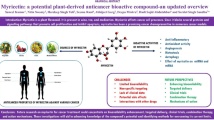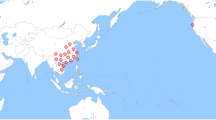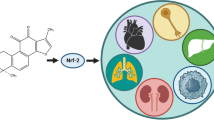Abstract
Natural products are rich in several potent bioactive compounds, targeting complex network of proteins involved in various diseases. Vitex negundo (VN), commonly known as “chaste tree”, is an ethnobotanically important plant with enormous medicinal properties. Different species of Vitex vary in chemical composition, thus producing different phytochemicals. Several bioactive compounds have been extracted from leaves, seeds, roots in form of volatile oils, flavonoids, lignans, iridoids, terpenes, and steroids. These bioactive compounds exhibit anti-inflammatory, antioxidant, antidiabetic, anticancer, antimicrobial. VN is typically known for its role in the modulation of cellular events like apoptosis, cell cycle, motility of sperms, polycystic ovary disease, and menstrual cycle. VN, reportedly, perturbs many cancer-signaling pathways involving p-p38, p-ERK1/2, and p-JNK in LPS-elicited cells, N-terminal kinase (JNK), COX-1 pathways, MAPK, NF-κB, tumor necrosis factor α (TNF-α), Akt, mTOR, vascular endothelial growth factor, hypoxia-inducible factor (HIF-1α). Several bioactive compounds obtained from VN have been commercialized and others are under investigation. This is the first review presenting up-to-date information about the VN, its bioactive constituents and their mode of action.

Similar content being viewed by others
References
Gill BS, Kumar S (2016) Triterpenes in cancer: significance and their influence. Mol Biol Rep 43(9):881–896
Negi A, Gill BS (2013) Success stories of enolate form of drugs. PharmaTutor 1(2):45–53
Ganapaty S, Vidyadhar K (2005) Phytoconstituents and biological activities of Vitex-a review. J Nat Rem 5(2):75–95
Vishwanathan A, Basavaraju R (2010) A review on Vitex negundo L.: a medicinally important plant. Eur J Biol Sci 3(1):30–42
Chandramu C, Manohar RD, Krupadanam DG, Dashavantha RV (2003) Isolation, characterization and biological activity of betulinic acid and ursolic acid from Vitex negundo L. Phytother Res 17(2):129–134
Chaturvedi G, Singh R (1965) Experimental studies on the antiarthritic effect of certain indigenous drugs. Indian J Med Res 53:71
Sirait M, Rimpler H, Haensel R (1962) Flavonoide aus Vitex agnus castus L. Experientia 18(2):72–72
Hebbalkar D, Hebbalkar G, Sharma R, Joshi V, Bhat V (1992) Mosquito repellent activity of oils from Vitex negundo Linn. leaves. Indian J Med Res 95:200–203
Parveen N (1991) Antifilarial activity of Vitex negundo against Setaria cervi. Fitoterapia 62:163–165
Chawla A, Sharma A, Handa S, Dhar K (1992) Chemical investigation and anti-inflammatory activity of Vitex negundo seeds. J Nat Prod 55(2):163–167
Gill BS, Sharma P, Kumar S (2016) Chemical composition and antiproliferative, antioxidant, and proapoptotic effects of fruiting body extracts of the Lingzhi or Reishi medicinal mushroom, Ganoderma lucidum (Agaricomycetes), from India. Int J Med Mushrooms 18(7):599–607
Dutta PK, Chowdhury US, Chakravarty AK, Achari B, Pakrashi SC (1983) Studies on Indian medicinal plants-part LXXV: Nishindaside, a novel iridoid glycoside from Vitex negundo. Tetrahedron 39(19):3067–3072
Singh V, Dayal R, Bartley JP (1999) Volatile constituents of Vitex negundo leaves. Planta Med 65(6):580–582
Ling TJ, Ling WW, Chen YJ, Wan XC, Xia T, Du XF, Zhang ZZ (2010) Antiseptic activity and phenolic constituents of the aerial parts of Vitex negundo var. cannabifolia. Molecules 15(11):8469–8477
Gautam L, Shrestha S, Wagle P, Tamrakar B (2008) Chemical constituents from Vitex negundo (Linn.) of nepalese origin. Sci World 6(6):27–32
Malik A, Khan M, Khan S, Ahmad A, Choudhary M (2006) Tyrosinase inhibitory lignans from the methanol extract of the roots of Vitex negundo Linn. and their structure-activity relationship. Phytomedicine 13(4):255–260
Malik A, Anis I, Khan SB, Ahmed E, Ahmed Z, Nawaz SA, Choudhary MI (2004) Enzymes inhibiting lignans from Vitex negundo. Chem Pharm Bull 52(11):1269–1272
Prajapati V, Tripathi A, Khanuja S, Kumar S (2003) Anti-insect screening of medicinal plants from Kukrail Forest, Lucknow, India. Pharm Biol 41(3):166–170
Umamaheswari M, AsokKumar K, Somasundaram A, Sivashanmugam T, Subhadradevi V, Ravi TK (2007) Xanthine oxidase inhibitory activity of some Indian medical plants. J Ethnopharmacol 109(3):547–551
Zargar M, Shameli K, Najafi GR, Farahani F (2014) Plant mediated green biosynthesis of silver nanoparticles using Vitex negundo L. extract. J Ind Eng Chem 20(6):4169–4175
Alam M, Gomes A (2003) Snake venom neutralization by Indian medicinal plants (Vitex negundo and Emblica officinalis) root extracts. J Ethnopharmacol 86(1):75–80
Arulvasu C, Prabhu D, Manikandan R, Srinivasan P, Dinesh D, Babu G, Sellamuthu S (2010) Induction of apoptosis by the aqueous and ethanolic leaf extract of Vitex negundo L. in MCF-7 human breast cancer cells. Int J Drug Discov 2(1):1–7
Sathiamoorthy B, Gupta P, Kumar M, Chaturvedi AK, Shukla P, Maurya R (2007) New antifungal flavonoid glycoside from Vitex negundo. Bioorg Med Chem Lett 17(1):239–242
Hossain M, Paul N, Sohrab M, Rahman E, Rashid M (2001) Antibacterial activity of Vitex trifolia. Fitoterapia 72(6):695–697
Woradulayapinij W, Soonthornchareonnon N, Wiwat C (2005) In vitro HIV type 1 reverse transcriptase inhibitory activities of Thai medicinal plants and Canna indica L. rhizomes. J Ethnopharmacol 101(1):84–89
Banerji A, Chadha M, Malshet V (1969) Isolation of 5-hydroxy-3, 6, 7, 3′, 4′-pentamethoxy flavone from Vitex negundo. Phytochemistry 8(2):511–512
Sehgal C, Taneja S, Dhar K, Atal C (1982) 2′-p-Hydroxybenzoyl mussaenosidic acid, a new iridoid glucoside from Vitex negundo. Phytochemistry 21(2):363–366
Khare C (2004) Encyclopedia Indian Medicinal Plant-Rational western therapy, Ayurvedic and other traditional usage, Botany. Springer, New York
Surveswaran S, Cai Y-Z, Corke H, Sun M (2007) Systematic evaluation of natural phenolic antioxidants from 133 Indian medicinal plants. Food Chem 102(3):938–953
Zheng C-J, Tang W-Z, Huang B-K, Han T, Zhang Q-Y, Zhang H, Qin L-P (2009) Bioactivity-guided fractionation for analgesic properties and constituents of Vitex negundo L. seeds. Phytomedicine 16(6):560–567
Vishnoi SP, Shoeb A, Kapil RS, Popli SP (1983) A furanoeremophilane from Vitex negundo. Phytochemistry 22(2):597–598
Khokra S, Prakash O, Jain S, Aneja K, Dhingra Y (2008) Essential oil composition and antibacterial studies of Vitex negundo Linn. extracts. Indian J Pharm Sci 70(4):522
Gill BS, Alex JM, Kumar S (2016) Missing link between microRNA and prostate cancer. Tumor Biol 37(5):1–22
Gill BS, Sharma P, Kumar R, Kumar S (2015) Misconstrued versatility of Ganoderma lucidum: a key player in multi-targeted cellular signaling. Tumor Biol 37(3):2789–2804
Dharmasiri M, Jayakody J, Galhena G, Liyanage S, Ratnasooriya W (2003) Anti-inflammatory and analgesic activities of mature fresh leaves of Vitex negundo. J Ethnopharmacol 87(2):199–206
Liu C, Tseng A, Yang S (2004) Chinese herbal medicine: modern applications of traditional formulas. CRC Press, Boca Raton
Tarafder C (1987) Some traditional knowledge about tribal health. Folklore 28(2):37–42
Zheng C-J, Huang B-K, Han T, Zhang Q-Y, Zhang H, Rahman K, Qin L-P (2009) Nitric oxide scavenging lignans from Vitex negundo seeds. J Nat Prod 72(9):1627–1630
Rosa SIG, Rios-Santos F, Balogun SO, de Oliveira Martins DT (2016) Vitexin reduces neutrophil migration to inflammatory focus by down-regulating pro-inflammatory mediators via inhibition of p38, ERK1/2 and JNK pathway. Phytomedicine 23(1):9–17
Ono M, ITO Y, Kubo S, Nohara T (1997) Two New iridoids from Viticis trifoliae Fructus (Fruit of Vitex rotundiSolia L.). Chem Pharm Bull 45(6):1094–1096
Chattopadhyay P, Hazarika S, Dhiman S, Upadhyay A, Pandey A, Karmakar S, Singh L (2012) Vitex negundo inhibits cyclooxygenase-2 inflammatory cytokine-mediated inflammation on carrageenan-induced rat hind paw edema. Pharmacogn Res 4(3):134
Lee H, Jung K-H, Lee H, Park S, Choi W, Bae H (2015) Casticin, an active compound isolated from Vitex Fructus, ameliorates the cigarette smoke-induced acute lung inflammatory response in a murine model. Int Immunopharmacol 28(2):1097–1101
Gill BS, Kumar S (2016) Evaluating anti-oxidant potential of ganoderic acid A in STAT 3 pathway in prostate cancer. Mol Biol Rep 43(12):1411–1422
Hu P, Li D-H, Jia C-C, Liu Q, Wang X-F, Li Z-L, Hua H-M (2017) Bioactive constituents from Vitex negundo var. heterophylla and their antioxidant and α-glucosidase inhibitory activities. J Funct Foods 35:236–244
Kadir FA, Kassim NM, Abdulla MA, Yehye WA (2013) Effect of oral administration of ethanolic extract of Vitex negundo on thioacetamide-induced nephrotoxicity in rats. BMC Complement Altern Med 13(1):294
Gautam K, Kumar P, Poonia S (2013) Larvicidal activity and GC-MS analysis of flavonoids of Vitex negundo and Andrographis paniculata against two vector mosquitoes Anopheles stephensi and Aedes aegypti. J Vector Borne Dis 50(3):171
Kamruzzaman M, Bari SN, Faruque SM (2013) In vitro and in vivo bactericidal activity of Vitex negundo leaf extract against diverse multidrug resistant enteric bacterial pathogens. Asian Pac J Trop Med 6(5):352–359
Nwodo N, Okoye F, Lai D, Debbab A, Kaiser M, Brun R, Proksch P (2015) Evaluation of the in vitro trypanocidal activity of methylated flavonoid constituents of Vitex simplicifolia leaves. BMC Complement Altern Med 15(1):1
Gill BS, Mehra R, Kumar V, Kumar S (2017) Ganoderic acid, lanostanoid triterpene: a key player in apoptosis. Invest New Drugs 36(1):136–143
Zhou Y, Liu YE, Cao J, Zeng G, Shen C, Li Y, Zhou M, Chen Y, Pu W, Potters L (2009) Vitexins, nature-derived lignan compounds, induce apoptosis and suppress tumor growth. Clin Cancer Res 15(16):5161–5169
Zhou J, Hu H, Long J, Wan F, Li L, Zhang S, Shi YE, Chen Y (2013) Vitexin 6, a novel lignan, induces autophagy and apoptosis by activating the Jun N-terminal kinase pathway. Anticancer Drugs 24(9):928–936
Gill BS, Navgeet, Kumar S (2017) Ganoderma lucidum targeting lung cancer signaling: a review. Tumor Biol 39(6):1010428317707437
Awale S, Linn TZ, Li F, Tezuka Y, Myint A, Tomida A, Yamori T, Esumi H, Kadota S (2011) Identification of chrysoplenetin from Vitex negundo as a potential cytotoxic agent against PANC-1 and a panel of 39 human cancer cell lines (JFCR-39). Phytother Res 25(12):1770–1775
Díaz F, Chávez D, Lee D, Mi Q, Chai H-B, Tan GT, Kardono LB, Riswan S, Fairchild CR, Wild R (2003) Cytotoxic flavone analogues of vitexicarpin, a constituent of the leaves of Vitex negundo. J Nat Prod 66(6):865–867
Kim KM, Heo DR, Lee J, Park J-S, Baek M-G, Yi J-M, Kim H, Bang O-S (2015) 5, 3′-Dihydroxy-6, 7, 4′-trimethoxyflavanone exerts its anticancer and antiangiogenesis effects through regulation of the Akt/mTOR signaling pathway in human lung cancer cells. Chem Biol Interact 225:32–39
Deng J, Zhang Y, Tan Z (2013) [Proliferation and apoptosis of choriocarcinoma cell JEG-3 induced by VB2 and its in vitro mechanism. J Cent South Univ Med Sci 38(5):476–482
Hu H, Zhou J, Wan F, Dong L, Zhang F, Wang Y, Chen F, Chen Y (2012) Effect of Evn-50 on cell growth and apoptosis in tamoxifen-resistance human breast cancer cell line MCF-7/TAM-R. J Zhejiang Univ Med Sci 41(5):498–505
Liou C-J, Len W-B, Wu S-J, Lin C-F, Wu X-L, Huang W-C (2014) Casticin inhibits COX-2 and iNOS expression via suppression of NF-κB and MAPK signaling in lipopolysaccharide-stimulated mouse macrophages. J Ethnopharmacol 158:310–316
Bhargava S (1989) Antiandrogenic effects of a flavonoid-rich fraction of Vitex negundo seeds: a histological and biochemical study in dogs. J Ethnopharmacol 27(3):327–339
Vasudeva N, Sharma SK, Mor A (2012) Spermicidal and post-coital anti-fertility activity of Vitex negundo stem bark. J Herbs Spices Med Plants 18(4):287–303
Loch E-G, Selle H, Boblitz N (2000) Treatment of premenstrual syndrome with a phytopharmaceutical formulation containing Vitex agnus castus. J Women’s Health Gender-Based Med 9(3):315–320
Roemheld-Hamm B (2005) Chasteberry. Am Fam Phys 72(5):821–824
Williamson EM (2006) Interactions between herbal and conventional medicines: the role of cytochrome P450 enzymes and P-glycoprotein. Pharmacologyonline 2:200–205
Sliutz G, Speiser P, Schultz A, Spona J, Zeillinger R (1993) Agnus castus extracts inhibit prolactin secretion of rat pituitary cells. Horm Metab Res 25(5):253–255
Jarry H, Leonhardt S, Gorkow C, Wuttke W (1993) In vitro prolactin but not LH and FSH release is inhibited by compounds in extracts of Agnus castus: direct evidence for a dopaminergic principle by the dopamine receptor assay. Exp Clin Endocrinol 102(6):448–454
Wuttke W, Gorkow C, Jarry H (1995) Dopaminergic compounds in Vitex agnus castus. In: Phytopharmaka in Forschung und klinischer Anwendung. Springer, New York
Hu Y, Zhang Q-Y, Hou T-T, Xin H-L, Zheng H-C, Rahman K, Qin L-P (2007) Estrogen-like activities in Vitex species from China determined by a cell based proliferation assay. Die Pharmazie Int J Pharm Sci 62(11):872–875
Padmalatha K, Jayaram K, Raju N, Prasad M, Arora R (2009) Ethnopharmacological and biotechnological significance of Vitex. Biorem Biodiv Bioavail 3(1):6–14
Ravichandran G, Bharadwaj VS, Kolhapure S (2004) Evaluation of efficacy and safety of acne-N-pimple cream in acne vulgaris. Antiseptic 101(12):249
Arentz S, Abbott JA, Smith CA, Bensoussan A (2014) Herbal medicine for the management of polycystic ovary syndrome (PCOS) and associated oligo/amenorrhoea and hyperandrogenism; a review of the laboratory evidence for effects with corroborative clinical findings. BMC Complement Altern Med 14(1):1
Liu H, Sui X, Li X, Li Y (2013) Lyoniresinol inhibits melanogenic activity through the induction of microphthalmia-associated transcription factor and extracellular receptor kinase activation. Mol Cell Biochem 373(1–2):211–216
Kadir FA, Kassim NM, Abdulla MA, Yehye WA (2013) PASS-predicted Vitex negundo activity: antioxidant and antiproliferative properties on human hepatoma cells-an in vitro study. BMC Complement Altern Med 13(1):343
Sahare K, Anandhraman V, Meshram V, Meshram S, Reddy M, Tumane P, Goswami K (2008) Anti-microfilarial activity of methanolic extract of Vitex negundo and Aegle marmelos and their phytochemical analysis. Indian J Exp Biol 46(2):128
Jiang L, Cao X-C, Cao J-G, Liu F, Quan M-F, Sheng X-F, Ren K-Q (2013) Casticin induces ovarian cancer cell apoptosis by repressing FoxM1 through the activation of FOXO3a. Oncol Lett 5(5):1605–1610
Arai MA, Fujimatsu T, Uchida K, Sadhu SK, Ahmed F, Ishibashi M (2013) Hh signaling inhibitors from Vitex negundo; naturally occurring inhibitors of the GLI1–DNA complex. Mol BioSyst 9(5):1012–1018
Li M-M, Su X-Q, Sun J, Gu YF, Huang Z, Zeng KW, Zhang Q, Zhao YF, Ferreira D, Zjawiony JK (2014) Anti-inflammatory Ursane-and Oleanane-Type Triterpenoids from Vitex negundo var. cannabifolia. J Nat Prod 77(10):2248–2254
Xin H, Kong Y, Wang Y, Zhou Y, Zhu Y, Li D, Tan W (2013) Lignans extracted from Vitex negundo possess cytotoxic activity by G2/M phase cell cycle arrest and apoptosis induction. Phytomedicine 20(7):640–647
Umamaheswari M, Asokkumar K, Umamageswari N, Sivashanmugam T, Subhadradevi V (2012) Protective effect of the leaves of Vitex negundo against ethanol-induced cerebral oxidative stress in rats. Tanzan J Health Res. https://doi.org/10.4314/thrb.v14i1.5
Sundaram R, Naresh R, Shanthi P, Sachdanandam P (2012) Antihyperglycemic effect of iridoid glucoside, isolated from the leaves of Vitex negundo in streptozotocin-induced diabetic rats with special reference to glycoprotein components. Phytomedicine 19(3):211–216
Tan Z, Zhang Y, Deng J, Zeng G, Zhang Y (2012) Purified vitexin compound 1 suppresses tumor growth and induces cell apoptosis in a mouse model of human choriocarcinoma. Int J Gynecol Cancer 22(3):360–366
Agarkar G, Jogee P, Paralikar P, Rai M (2015) Vitex negundo: bioactivities and products. Therapeutic medicinal plants: from lab to the market. CRC Press, Boca Raton
Daniele C, Coon JT, Pittler MH, Ernst E (2005) Vitex agnus castus. Drug Saf 28(4):319–332
Wuttke W, Jarry H, Christoffel V, Spengler B, Seidlova-Wuttke D (2003) Chaste tree (Vitex agnus-castus)—pharmacology and clinical indications. Phytomedicine 10(4):348–357
Chattopadhyay P, Banerjee S, Pathak MP, Agnihotri A, Karmakar S, Goyary D, Dhiman S, Veer V (2014) Acute and subchronic dermal toxicity of Vitex negundo essential oil. Cutane Ocul Toxicol 33(1):16–21
Lucks BC, Sørensen J, Veal L (2002) Vitex agnus-castus essential oil and menopausal balance: a self-care survey. Complement Ther Nurs Midwifery 8(3):148–154
Khan A, Naz S, Farooq U, Shahid M, Ullah I, Ali I, Rauf A, Mabkhot YN (2018) Bioactive chromone constituents from Vitex negundo alleviate pain and inflammation. J Pain Res 11:95–102
Acknowledgements
The authors are thankful to Central University of Punjab, India, for providing the necessary facilities to carry out this work.
Author information
Authors and Affiliations
Corresponding authors
Ethics declarations
Conflict of interest
The authors declare that they have no conflict of interest.
Informed consent
Informed consent was obtained from all individual participants included in the study.
Rights and permissions
About this article
Cite this article
Gill, B.S., Mehra, R., Navgeet et al. Vitex negundo and its medicinal value. Mol Biol Rep 45, 2925–2934 (2018). https://doi.org/10.1007/s11033-018-4421-3
Received:
Accepted:
Published:
Issue Date:
DOI: https://doi.org/10.1007/s11033-018-4421-3




